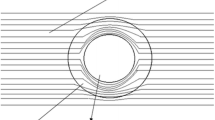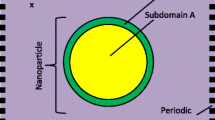Abstract
Nanofluids, a new class of solid/liquid suspensions, offer scientific challenges because their measured thermal conductivity is one order of magnitude greater than predictions. It has long been known that liquid molecules close to a solid surface form layered solid-like structures, but little is known about the connection between this nanolayer and the thermal properties of the suspensions. Here, we have modified the Maxwell equation for the effective thermal conductivity of solid/liquid suspensions to include the effect of this ordered nanolayer. Because this ordered nanolayer has a major impact on nanofluid thermal conductivity when the particle diameter is less than 10 nm, a new direction is indicated for development of next-generation coolants.
Similar content being viewed by others
References
Chen, G., 1997. Size and interface effects on thermal conductivity ofsuperlattices and periodic thin-film structures. J. Heat Transfer 119, 220–229.
Cheng, S.C. & R.I. Vachon, 1969. The prediction of the thermal conductivity of two andthree phase solid heterogeneous mixtures. Int. J. Heat Mass Transfer 12, 249–264.
Choi, S.U.S., 1995. Enhancing thermal conductivity of fluids with nanoparticles. In:Siginer, D.A. and Wang, H.P. eds. Developments and Applications of Non-Newtonian Flows, ASME, New York, FED ¶ Vol. 231/MD ¶ Vol. 66, pp. 99–105.
Choi, S.U.S.,Z.G. Zhang, W. Yu, F.E. Lockwood & E.A. Grulke, 2001. Anomalous thermal conductivity enhancement in nanotube suspension. Appl. Phys. Lett. 79(14), 2252–2254.
Davis, L.C. & B.E. Artz, 1995. Thermal conductivity of metal-matrix composites. J.Appl. Phys. 77(10), 4954–4960.
Devpura, A., P.E. Phelan & R.S. Prasher,2001. Size effect on the thermal conductivity of polymers laden with highly conductive filler particles. Microscale Thermophys. Eng. 5, 177–189.
Eastman, J.A., S.U.S. Choi, S. Li, W. Yu & L.J. Thompson, 2001. Anomalously increased effective thermal conductivity of ethylene glycol-based nanofluids containing copper nanoparticles. Appl. Phys. Lett. 78(6), 718–720.
Every, A.G., Y. Tzou, D.P.H. Hasselman & R. Raj, 1992. The effect ofparticle size on the thermal conductivity of ZnS/diamond composites. Acta Metall. Mater. 40(1), 123–129.
Hamilton, R. L. & O.K. Crosser, 1962. Thermal conductivityof heterogeneous two-component systems. I & EC Fundamentals 1, 187–191.
Henderson, J.R. & F. van Swol, 1984. On the interface between a fluid and a planarwall:Theory and simulations of a hard sphere fluid at a hard wall. Mol. Phys. 51, 991–1010.
Jeffrey, D.J., 1973. Conduction through a random suspension of spheres. Proc. R. Soc.London, Ser. A 335, 355–367.
Lee, S., S.U.S. Choi, S. Li & J.A. Eastman,1999. Measuring thermal conductivity of fluids containing oxide nanoparticles. J. Heat Transfer 121, 280–289.
Maxwell, J.C., 1873. Electricity and Magnetism.Clarendon Press, Oxford, UK.
Schwartz, L.M., E.J. Garboczi & D.P. Bentz, 1995.Interfacial transport in porous media: Application to DC electrical conductivity of mortars. J. Appl. Phys. 78(10), 5898–5908.
Torquato, S. & M.D. Rintoul, 1995. Effect of theinterface on the properties of composite media. Phys. Rev. Lett. 75(22), 4067–4070.
Yu, C.-J., A.G. Richter, A. Datta, M.K. Durbin & P. Dutta, 2000. Molecular layeringin a liquid on a solid substrate: An X-ray reflectivity study. Physica B 283, 27–31.
Author information
Authors and Affiliations
Corresponding author
Rights and permissions
About this article
Cite this article
Yu, W., Choi, S. The Role of Interfacial Layers in the Enhanced Thermal Conductivity of Nanofluids: A Renovated Maxwell Model. Journal of Nanoparticle Research 5, 167–171 (2003). https://doi.org/10.1023/A:1024438603801
Issue Date:
DOI: https://doi.org/10.1023/A:1024438603801




